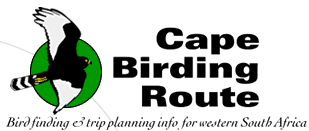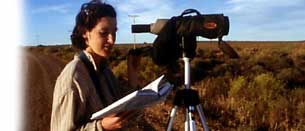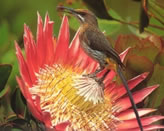Paarl
Mountain and Bird Sanctuary:
The
oak and jacaranda-lined streets of Paarl lie along the banks
of the Berg River, at the eastern foot of the low, sprawling
massif of Paarl Mountain. The massif offers good fynbos birding
and is a well-known site for the inconspicuous and elusive
Protea
Canary (p.57*). A few kilometres north of the town
centre is the Paarl Bird Sanctuary, a picturesque and productive
sewage works that attracts an excellent diversity of waterbirds.
These include several species that are otherwise fairly scarce
close to Cape Town, such as Little Bittern, Lesser
Flamingo, White-backed and African Black Ducks,
Water Dikkop and Malachite Kingfisher.
Access
to Paarl from the N1 national road from Cape Town can be confusing:
there are two off-ramps to Paarl, and it is the first and
rather inconspicuously marked ‘R45: Main Road’ turn-off
that you need to take. The soaring monument to your left honours
the Afrikaans language. The Paarl Mountain Nature Reserve,
incorporating a small wildflower garden in one of its wooded
valleys, is easily reached from Main Road. At 1, turn left
(1.6 km north of the off-ramp), onto Jan Phillips Mountain
Drive.
The
drive winds up through vineyards, then contours northwards,
passing the wildflower garden at 2, and the turn-off to the
mountain reserve at 3.
The
wildflower reserve is a small, pleasant botanical garden that
often holds large numbers of confiding Cape
Sugarbirds (p.33*) and Orange-breasted
Sunbirds (p.33*). Other common species to be found
here are Black Saw-wing Swallow, Cape Bulbul,
Bar-throated Apalis, Fiscal Flycatcher, Cape
Batis, Malachite Sunbird and an assortment of canaries,
including Streaky-headed Canary and, towards the top
of the garden, the occasional Protea
Canary.
Just
beyond the wildflower reserve, at 3, you can turn left up
into the Paarl Mountain Nature Reserve. At the entrance gate
4, a left turn takes you along a good gravel road to the base
of Britannia Rock, whereas a right turn leads on to the network
of roads that encircles the rolling plateau of the mountain
top. The latter is recommended more for its scenic than its
birding merits.
At
5, a path up to the 650-m crest of Britannia Rock has been
cut into the granite, and, despite the often-present wind,
it is well worth the climb. There are sweeping views of the
Cape winelands and wheatlands set against the dramatic backdrop
of the great ranges of Cape mountains that separate the coastal
plain from the interior. Raptors such as Black Eagle,
Jackal Buzzard and Peregrine Falcon are often
seen wheeling about the rock domes. Other notable birds of
this area are Ground
Woodpecker (p.105*), African Black Swift and
Cape
Siskin (p.33*). Although Protea
Canary occur in denser stands of mountain fynbos throughout
the massif, the bird is never easy to find.
The
friendly, manageable character of the Paarl Bird Sanctuary
(pictured below) contrasts strongly with the stark, windy
nature of its Capetonian counterpart, the Strandfontein sewage
works (see p.26). Paarl offers two well-positioned hides,
a good diversity of habitats within a modest area, and almost
guaranteed sightings of several tricky species.
Malachite
Kingfisher, never an easy bird
in Cape Town, is invariably present in secluded, reed-fringed
inlets, such as those at the southern end of pan 1. This pan
is also a good site for White-backed Duck, Purple
Gallinule, and, in summer, White-throated Swallow
and Red Bishop are much in evidence. It is also perhaps
the best place in the Cape to see Little Bittern, which
is occasionally observed perching at or flying along the reedbed
edges. The excellent bird hide here was unfortunately burnt
down, but there are plans to replace it.
The
alien thicket adjacent to this pan is overrun with African
Marsh Warblers and Paradise Flycatchers during
summer. From here, drive on to the hide at the northern end
of pan 2, which usually produces an excellent diversity of
ducks. The hide holds special significance for South Africa’s
best known birder, Ian Sinclair, who ticked his landmark 900th
species for southern Africa here, in the form of a vagrant
American Purple Gallinule. In addition to the usual
widespread waterbirds, several more interesting species can
be seen here, among them Southern Pochard, Maccoa
Duck, the occasional White-faced Duck (a bird that
has been resident in the Cape for less than a decade, and
is still scarce) and, oddly, the more typically mountain-stream
loving African Black Duck, which visits from the adjacent
Berg River.
Pan
3 is the closest place to Cape Town where Lesser Flamingo
can be found, often flocking conveniently alongside the more
widespread Greater Flamingo. In summer, keep a look
out for the large flocks of fluttering White-winged Terns.
In pan 4, an island supports a heronry where, among others,
Black-crowned Night Heron breed. African Fish Eagles
often roost in the gum trees at the far side, and Common
Sandpiper and Ethiopian Snipe feed in the roadside
ditch between pans 3 and 4. Returning towards the entrance
gate, turn right to the hide at 5. The sandbank in front of
this hide usually lures a good diversity of migrant waders,
including the localized Common Sandpiper. The reeds
here hold Black Crake, and Baillon’s Crake
has also been recorded. Before leaving, take a scan around
the sewage mixing enclosures at 6, where a loose group of
Water Dikkop usually eyes one disapprovingly.
|


